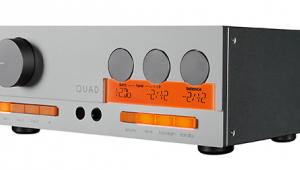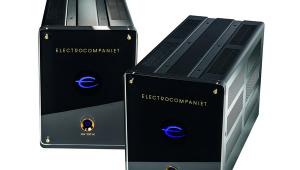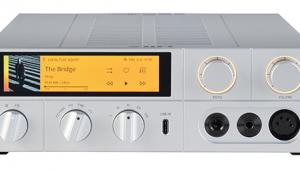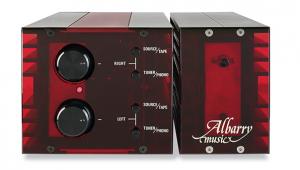Primare I15 Prisma networked amplifier

 This neatly packaged, sleekly-styled Scandinavian integrated offers DAC and streaming functionality, plus a very fine sound thanks to its proven Class D power amp modules
This neatly packaged, sleekly-styled Scandinavian integrated offers DAC and streaming functionality, plus a very fine sound thanks to its proven Class D power amp modules
Many think of Apple as creating today’s world of sleek, minimalist consumer electronics – but the business and creative heads of that Californian company – Steve Jobs and Jonathan Ive – were themselves inspired by great talents working in hi-fi, long before the iconic iPod was ever launched. Lest we forget, Jacob Jensen did amazing industrial design work at Bang & Olufsen for decades, as did Dieter Rams at Braun 15 years earlier.
Less well known perhaps is Clas-Göran Wanning, who brought clean, crisp style to Sonab’s range of hi-fi separates. Now, one might say that Swedish-based Primare has picked up the baton. Since its inception in the early ’80s, Primare has come up with some striking hi-fi products. Founded by Danish designer and audiophile Bo Christensen, it has always been concerned with making fine sounding, lovely-to-use equipment. The new I15 Prisma is the company’s most compact, lifestyle-orientated product and retails for £1600.
Cross Platform
It’s a preamplifier, DAC and power amp built into one small box, and features Primare’s own control and connectivity platform called Prisma. This is a ‘one-stop shop’ for most people’s digital media needs, offering the full spectrum of system management from a single control point. It offers Wi-Fi and Bluetooth streaming, network-attached storage playback plus multi-room/multi-zone connectivity and control. And all this is managed via the crisp-looking, neatly ordered Prisma application, available on both iOS and Android smartphone platforms.
Such impressive functionality is wrapped in a three-quarter sized (350x73x329mm, 6.4kg) case, which is all the more surprising when you consider that the I15 Prisma offers a rated output of 60W/8ohm courtesy of two tried-and-tested Hypex Class D amplifier modules [see PM’s Classy Class D sidebar and Lab Report]. There’s a fairly heavy-duty, custom-designed switch-mode power supply fitted inside while the DAC section employs the respected AK4490EQ part from AKM. It also plays the usual WAV, AIFF, FLAC, ALAC, MP3, MP4 (AAC), WMA and OGG files, so won’t have a problem with legacy computer audio.
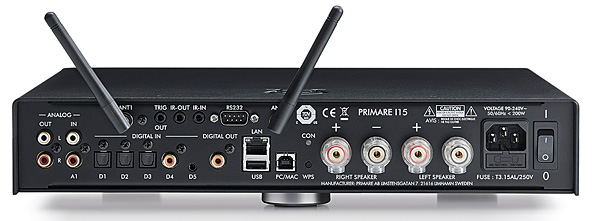
The preamp section’s relay-selected inputs are said to give better isolation than conventional switches. Short signal paths are used, with two and four-layer double-sided circuit board construction and surface-mount components employed whenever possible. The busy rear panel has three optical digital inputs, one coaxial and one 3.55mm mini-plug – all running up to 192kHz/24-bit PCM. The USB-B input goes to 384kHz/24-bit and DSD5.6/128. Two screw-in Wi-Fi antennae are accommodated alongside two Ethernet sockets, two pairs of RCA analogue inputs, a set of loudspeaker binding posts and control socketry for system integration.
Despite its relative lack of buttons, the I15 Prisma is highly configurable, with a sharp OLED display revealing options to adjust the balance, maximum volume, mute volume, start-up volume, etc. You can get the amp to display all the inputs, or only those with signal going in, and change the names of the inputs. There’s adjustable input gain and a front panel lock feature, among many other facilities.
The front panel switchgear confers a sense of precision and quality, and it looks handsome in either Black or Titanium finishes. Considering its great flexibility, the Prisma control app makes managing music very straightforward. It offers easy access to networked music, Bluetooth, AirPlay and streaming services such as Spotify Connect, includes ‘Chromecast built-in’ and is a Roon end point. It also gives you control of the amp’s other inputs via its menu system. The supplied remote doesn’t let the show down either – with its slimline proportions, rubberised buttons and a case made from smooth plastic, it feels good to use.
![]() Shine On
Shine On
There’s something instinctively right about the sound here. Despite its diminutive dimensions, the I15 Prisma presents a thoroughly respectable face to the audiophile world. There’s a wide soundstage inside which you hear a goodly amount of detail. Tonally it’s very smooth and the textures of different instruments are rendered with pleasing realism. What’s more, it never runs out of steam at sane listening levels when partnered with sensible loudspeakers, even on quite densely produced music.











